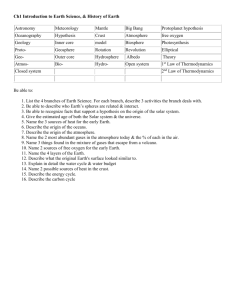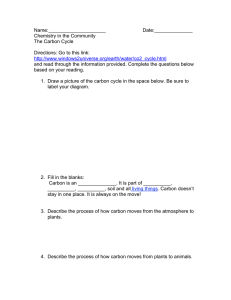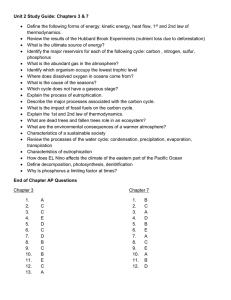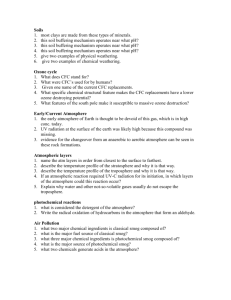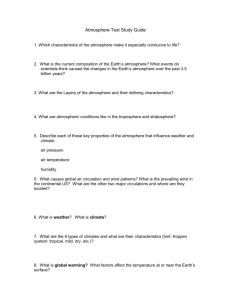APES Final Study Guide
advertisement
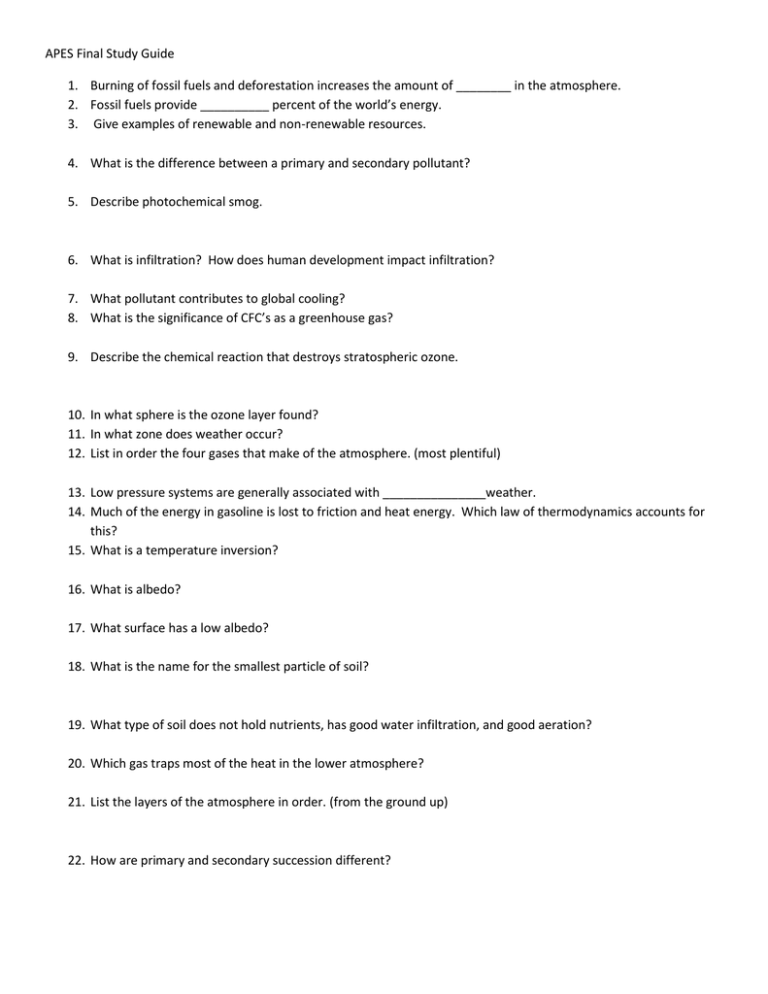
APES Final Study Guide 1. Burning of fossil fuels and deforestation increases the amount of ________ in the atmosphere. 2. Fossil fuels provide __________ percent of the world’s energy. 3. Give examples of renewable and non-renewable resources. 4. What is the difference between a primary and secondary pollutant? 5. Describe photochemical smog. 6. What is infiltration? How does human development impact infiltration? 7. What pollutant contributes to global cooling? 8. What is the significance of CFC’s as a greenhouse gas? 9. Describe the chemical reaction that destroys stratospheric ozone. 10. In what sphere is the ozone layer found? 11. In what zone does weather occur? 12. List in order the four gases that make of the atmosphere. (most plentiful) 13. Low pressure systems are generally associated with _______________weather. 14. Much of the energy in gasoline is lost to friction and heat energy. Which law of thermodynamics accounts for this? 15. What is a temperature inversion? 16. What is albedo? 17. What surface has a low albedo? 18. What is the name for the smallest particle of soil? 19. What type of soil does not hold nutrients, has good water infiltration, and good aeration? 20. Which gas traps most of the heat in the lower atmosphere? 21. List the layers of the atmosphere in order. (from the ground up) 22. How are primary and secondary succession different? 23. Define the following: a. Adaptive radiation b. Isolation c. Natural selection d. Stable gene pool e. Convergent evolution 24. A population that doubles in 110 years would have what percent growth? 25. What is the rule of 70? 26. Describe the first law of thermodynamics. 27. Describe the second law of thermodynamics. 28. What food source do the majority of nutrients and calories come from in an American diet? (Potatoes, corn, rice, wheat, soybeans, ???) 29. Place wheat , corn and rice in order of importance to humans. (as food) 30. What is an ecological footprint? What is the average American’s ecological footprint (in acres)? 31. What is Kwashiorkor? 32. What is most of the grain that is grown in the US used for? 33. What is the greatest threat to species survival? 34. What is the largest type of domestic solid waste in the US? 35. What is the number one use of freshwater? 36. Why do scientists check water for E.coli? 37. What nutrients stimulate algae to grow? 38. What is BOD and how does it effect dissolved oxygen? 39. Where is much of the worlds freshwater found? How about freshwater not in glaciers? 40. What is each of the following mostly known for? a. Ansel Adams b. Rachel Carsen c. Garrett Hardin d. Aldo Leopold e. Gifford Pinchot f. Jerry Garcia g. Randy Rhodes 41. Do cars emit CFC’s? 42. Give an example of a compound that is a secondary pollutant and a component of photochemical smog. 43. Give examples of biomass fuels. 44. Give examples of positive and negative feedback. 45. How can the pollution caused by coal be reduced? 46. How is coal classified? Which type has the most sulfur? 47. What is strip minning? 48. How is high level nuclear waste handled in the US? 49. Which fuel is most often used in fuel cells? 50. Which fuels is used for nuclear fusion? 51. In addition to ozone depletion how do CFC’s contribute to global warming? 52. Name the energy source that supplies most of the electrical power in the US. 53. Sulfur compounds are most associated with which fossil fuel? 54. The sun delivers (high/low) quality energy and the earth radiates (High/low) quality energy. 55. What are direct costs and indirect costs/externalities? 56. What are some impacts of groundwater overdrafting? 57. What does BOD stand for? 58. What is bioremediation? 59. What is entropy? 60. What is fecal coliform and what does it measure? 61. What is largest source of thermal water pollution? 62. What is synergism? 63. Explain how nuclear fusion can create energy. 64. Explain how nuclear fission can create energy. 65. What process do nuclear reactors use? 66. What type of mining usually causes the most surface disruption? 67. Which substance reflects most of the radiation escaping from earth? 68. Does agricultural runoff contribute to CO2 in the atmosphere? 69. What is the significance of oil shale and tar sands? 70. What is the environmental significance of the Colorado River? 71. What are some methods to reduce erosion? 72. Describe tragedy of the commons.

